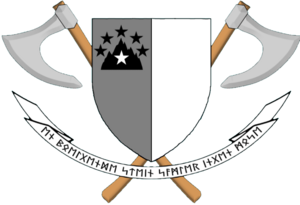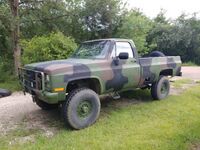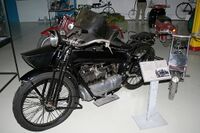Stonish Army
This article is incomplete because it is pending further input from participants, or it is a work-in-progress by one author. Please comment on this article's talk page to share your input, comments and questions. Note: To contribute to this article, you may need to seek help from the author(s) of this page. |
| Royal Stonish Army | |
|---|---|
| Noşokosīn Vedşotīdukosī | |
 The Coat of Arms of the Stonish Army | |
| Founded | 11 July 1624 |
| Country | |
| Type | Army |
| Role | Land warfare Strategic defence |
| Size | 25,000 active personnel 40,000+ reserved personnel |
| Part of | |
| Garrison/HQ | Vedotī, Flatstone |
| Motto(s) | "Posu Ekuş Īş!" "Land is Life!" |
| Colours | Gray, Black, and White |
| March | "Monobon Pokesīn" (Saints March) |
| Commanders | |
| Commander-in-Chief | |
| Chief of Staff of Army High Command | |
| Field Marshal | |
| Insignia | |
| Insignia |  |
The Royal Stonish Army (Northern Ivili: Noşokosīn Vedşotīdukosī; abbreviated NVD) is the army branch of the Stonish Armed Forces. Created on July 11th of 1624, it is the second largest branch of the greater Stonish Armed Forces.
The Stonish Army serves the purpose of defending the Stonish archipelago and overseas territories from internal and external threats under the command of the Chief of Staff of Army High Command and the Commander in Chief respectively, possessing upwards of 25,000 active personnel as of 2020. The Stonish Army is based in the Stonish capital of Szlād.
Structure
- Royal Family
- Army High Command
- National Army
- Ground Force
- Mountaineers
- Marines
- National Guard
- Expeditionaries
- National Army
- Army High Command
Current deployment
Personnel
Equipment
Infantry weapons
| Name | Type | Caliber | Origin | Notes | Image |
|---|---|---|---|---|---|
| Kīnŧānnə Əŧōmət Officer | Semi-automatic pistol | .32 ACP | Product of the Szŧōndōbī, issued to officers. | 
| |
| SDI-50 | Submachine gun | .32 ACP | Made by Szŧōndōbī. | 
| |
| SDE-53 Əŧōdōbī | Assault rifle | 7.62×39mm | Made by Szŧōndōbī in order to serve the purpose of a standard-issue assault rifle for the Stonish Army. | ||
| Szŧōndōbī M.G. | Light machine gun | 7.62×39mm | Introduced to the Stonish Army in the 20's, has remained in service as a secondary alternative to the SDE-60 as a SAW (Squad Automatic Weapon.) | 
| |
| SDE-60 | Light machine gun | 7.62x39mm | Made by Szŧōndōbī. Standard squad automatic weapon of the Stonish Army. | 
| |
| SD-47 | Bolt action | 7.62x39mm | Introduced in the late 40's, eventually replaced by the SDE-53; Still used in service as a general-purpose sniper rifle. | 
|
Support Equipment
| Name | Type | Caliber | Origin | Notes | Image | ||
|---|---|---|---|---|---|---|---|
| Autocannons | |||||||
| 20mm Əŧōkənōn | Autocannon | 20 mm caliber | Manufactured by Szŧōndōbī, often mounted on motorbikes and other motorized vehicles such as pickup trucks. | 
| |||
Vehicles
| Name | Type | Origin | Quantity | Notes | Image |
|---|---|---|---|---|---|
| Armoured vehicles | |||||
| Type Jia-2 | Main battle tank | 8 | Purchased by the Stonish Army from the Hoterallian government in 2021. | 
| |
| Utility Vehicles | |||||
| T74(M) | Pickup truck | 230 | Purchased and serviced by the Stonish Armed Forces in order to fulfill logistical needs. | 
| |
| Tīpō C | Motorcycle | 60 | Often gifted to officers and mountaineers in order to conduct routine patrols swiftly and effectively.. | 
| |
Organization
Sztōnājmī brigades are combined arms units prioritizing a solid combination of infantry artillery supported by an air-force designed to support the troops on the ground. The Sztōnājmī play a primarily defensive role, additionally specializing in reconnaissance and logistics. The Sztōnājmī is one centralized entity under the absolute control of the Stonish King and Flatstone itself, not claiming allegiance or any other form of political tie to any subdivision within the Stonish Federation. The brigades of the Stonish Army's sizes vary from 3,000 to 5,000 personnel.
Other units
Szŧōnɉōnzī
The Szŧōnɉōnzī were created by Stonish King Bjarn Von Stone in 1214 during the First Stonish War of Unification in order to fulfill his need for a primarily naval-based ground force capable of conducting extensive military operations throughout the Szŧōngānōnŧū archipelago. The organization saw huge amounts of success initially, most notably during their collaboration with Stonish Noble Gert Koch in his defense of northern-occupied Southern-Ivili territory, and under the command of Bjarn Von Stone during his victory in Sūnŧūgā Bay
National Guard
The Stonish National Guard is a subdivision of the Greater Stonish Army, often operating in cooperation with the Stonish Army in order to compensate for whenever there may be a lack of available manpower. The National Guard serves under the same leadership and tactics as that of the Stonish Army. The only difference between the two is that the National Guard is issued 1949 uniforms instead of the 2022 uniforms that are issued to members of the Stonish Army and the Royal Stonish Navy. It is also worth noting that the National Guard has less standard ranks than the Stonish Army, and that issued equipment is often older and less competent according to modern standards. Because of this, members of the National Guard are trained to use traditionally older firearms and equipment in order to make up for the setbacks presented by the usage of surplus equipment.
The National Guard wasn't officially created until 2008, when the need for a garrison force capable of quelling and containing the fires throughout the countryside became ever so apparent to the Stonish Crown. The similarities between the National Guard and the Regular Army were intentionally applied in order to make the transition from the Regular Army or other branches to the National Guard by members of the Stonish Armed Forces that were interested easier.
Mountaineers
The Royal Stonish Mountaineers are a subdivision of the Greater Stonish Army, serving the purpose of a royal guard in order to provide personal protection to members of the Stonish Royal family, and more specifically the Szlād Imperial Palace where members of the Stonish Royal Family have traditionally resided. The Royal Stonish Mountaineers, despite the namesake implying a role in mountaineering or mountain warfare, primarily serve the purpose of propaganda, and the protection of the Stonish Crown, sites of historical importance, churches, and museums or objects of religious or historical importance in general.
Marines
The Royal Stonish Marines are a subdivision of the Greater Stonish Army, providing an amphibious alternative to the National Guard and Regular Army. The Stonish Marines were designed to partake in aquatically-specific operations such as river crossings, island-hopping campaigns, amphibious landings, and coastal defense. The Royal Stonish Marines are the state-founded iteration of the independently-operating Szŧōnɉōnzī paramilitary organization.
The need for an amphibious force became serious in 1903-1904 when the Szŧōnɉōnzī began it's transition from a "mercenary" company to a paramilitary organization, effectively decommissioning the force in compliance with the nations laws. In response, the state drafted the idea for the Royal Stonish Marines as a secondary subdivision of the Stonish Army, next to the Royal Stonish mountaineers. Today, the Royal Stonish Marines often work in cooperation with the Szŧōnɉōnzī when it comes to domestic affairs, negotiating with the Szŧōnɉōnzī for guaranteed membership as well as access to financial and medical benefits for retiring or discharged members of the Royal Stonish Marines.

